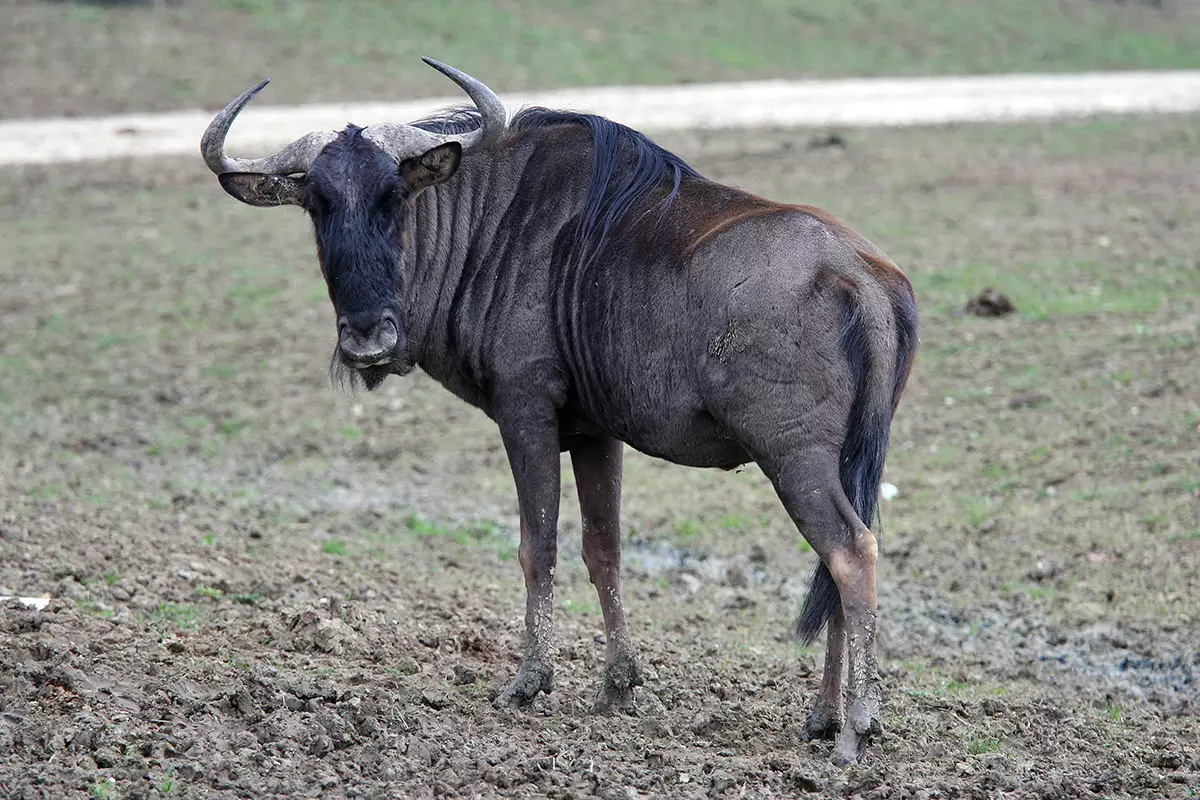
When it comes to the animal kingdom, there are few creatures as fascinating and unique as the gnu. Also known as the wildebeest, this large, herbivorous mammal is native to the grassy plains of Africa. With its distinctive appearance and migratory behavior, the gnu has long captured the attention of both wildlife enthusiasts and researchers alike.
In this article, we will explore 19 fascinating facts about the gnu, shedding light on its physical characteristics, behavior, and ecological significance. From its peculiar appearance to its impressive migration patterns, you’ll discover why the gnu is truly a remarkable animal. So, get ready to dive into the world of gnus and uncover some surprising and lesser-known facts about these magnificent creatures.
Key Takeaways:
- The Gnu, also known as the wildebeest, is a remarkable African mammal with a distinctive appearance, incredible migration, and vital role in maintaining the balance of ecosystems.
- Gnus are iconic symbols of the African wilderness, showcasing resilience, adaptability, and interconnectedness with other wildlife, making them a testament to the wonders of the natural world.
Gnu, also known as wildebeest, belongs to the antelope family.
The Gnu, scientific name Connochaetes, is a large African mammal that falls under the Bovidae family, which includes antelopes, cattle, and goats.
There are two species of Gnu – the Blue Wildebeest and the Black Wildebeest.
The Blue Wildebeest (Connochaetes taurinus) and the Black Wildebeest (Connochaetes gnou) are the two recognized species of Gnu, each with unique characteristics and habitats.
The Gnu has a distinctive appearance with its large head, curved horns, and muscular build.
These magnificent creatures can reach a height of up to 4.5 feet at the shoulder and weigh between 260 to 600 kilograms, making them one of the largest antelope species.
Gnus are herbivores and have a specialized digestive system to process tough grasses.
They have a complex four-chambered stomach and are able to extract maximum nutrients from the vegetation they consume, which primarily consists of grass and herbs.
The Gnu is known for its spectacular annual migration, covering vast distances in search of greener pastures.
These incredible animals partake in one of the largest terrestrial migrations on the planet, often traveling hundreds of miles in search of food and water.
Gnus possess remarkable coordination and agility, allowing them to move swiftly and navigate challenging terrains.
Their strong and sturdy build, combined with their ability to run at speeds up to 40 miles per hour, makes them well-adapted to the harsh African landscapes.
Gnu herds can consist of thousands of individuals, providing safety in numbers.
By gathering in large groups, Gnus increase their chances of survival, as predators find it difficult to single out a target amidst the chaos of a massive herd.
Male Gnus engage in dramatic territorial battles, known as “rutting.”
During the mating season, dominant males fiercely compete for the right to mate with females by locking horns and pushing against each other in impressive displays of strength.
The Gnu has an excellent sense of hearing and smell, enabling it to detect potential threats from a distance.
Their heightened senses play a crucial role in survival, helping them evade predators such as lions, hyenas, and crocodiles.
Female Gnus give birth to a single calf after a gestation period of about 8.5 months.
Interestingly, newborn calves are quick to stand and walk within minutes of birth, allowing them to keep up with the herd and reduce the risk of predation.
The migration of Gnus in the Serengeti is considered one of the Seven Natural Wonders of Africa.
Every year, millions of Gnus embark on a perilous journey, navigating rivers, grasslands, and woodlands, creating an awe-inspiring spectacle that draws tourists from around the world.
Gnus play a vital role in maintaining the balance of ecosystems as key grazers.
By consuming vast amounts of grass, they prevent vegetation from becoming overgrown, allowing new growth and supporting a variety of other herbivores and carnivores.
Gnus have an incredible ability to adapt to different environments, ranging from open plains to dense forests.
This adaptability has helped them thrive in various regions of Africa, from the Serengeti in Tanzania to the Kalahari Desert in Botswana.
The Gnu’s distinctive vocalizations, such as snorts, grunts, and moans, are used for communication within the herd.
These vocal exchanges serve to convey warnings, establish dominance, or reconnect separated members of the group.
Despite their robust appearance, Gnus are not known for being aggressive towards humans.
They are generally shy and prefer to keep their distance, but may become wary or defensive if they sense a threat.
Gnus have been immortalized in popular culture, often depicted in wildlife documentaries, photographs, and artwork.
Their iconic presence and captivating migration story have captured the imaginations of people around the world.
Gnus have a symbiotic relationship with other animals, such as birds and insects.
Certain bird species, like oxpeckers, often hitch rides on the backs of Gnus, feeding on ticks and other parasites that may be present on their skin.
The conservation status of Gnus varies depending on the species and their geographical range.
While the Blue Wildebeest is listed as Least Concern, the Black Wildebeest is classified as Near Threatened by the IUCN Red List due to habitat loss and hunting pressures.
Gnus are a symbol of the African wilderness, representing the beauty and resilience of the continent’s diverse wildlife.
Their epic migrations, robust nature, and unique behaviors make them a true testament to the wonders of the natural world.
As we delve into the remarkable facts about Gnu, we gain a deeper appreciation for this incredible creature and its significance in the animal kingdom. From their annual migrations to their symbiotic relationships, Gnus exemplify the adaptability and interconnectedness of wildlife in Africa.
The 19 facts about Gnu provide a glimpse into their fascinating lives and highlight their importance in maintaining the ecological balance of their habitats. Whether it’s their formidable appearance, their impressive territorial battles, or their vital role as grazers, Gnus capture our imagination and remind us of the wonders of the natural world.
So, the next time you hear about the Gnu, take a moment to reflect on these incredible creatures and the invaluable role they play in preserving the beauty and biodiversity of our planet.
Conclusion
In conclusion, Gnus are fascinating creatures that are often misunderstood. From their unique appearance to their behavior in the wild, there is so much to learn about these animals. Whether you’re interested in their habitat, their habits, or their interaction with humans, exploring the world of Gnus is sure to be an exciting adventure. Remember to appreciate these majestic creatures and their important role in the ecosystem. So, the next time you come across a Gnu in the wild or see them on nature documentaries, you’ll have a deeper understanding of their amazing attributes and remarkable characteristics.
FAQs
1. What is a Gnu?
A Gnu, also known as a Wildebeest, is a large African antelope characterized by its distinctive appearance and migration patterns.
2. How fast can Gnus run?
Gnus are incredibly fast runners and can reach speeds of up to 50 miles per hour, making them one of the fastest land animals.
3. Do Gnus migrate?
Yes, Gnus are known for their long-distance migrations in search of food and water. These migrations often involve thousands of animals moving together, creating an impressive sight.
4. What do Gnus eat?
Gnus are herbivores, primarily feeding on grasses and other vegetation. Their grazing habits play a crucial role in shaping the landscape of their habitats.
5. Are Gnus social animals?
Yes, Gnus are highly social animals and are often seen in large herds. They engage in complex social behaviors, including grooming, nursing, and group defense against predators.
6. Are Gnus endangered?
There are different species of Gnus, and their conservation status varies. While some species are not currently at risk, others, such as the Eastern White-bearded Gnu, are classified as endangered due to habitat loss and hunting.
7. Can Gnus defend themselves?
Yes, Gnus can defend themselves, particularly when faced with predators such as lions or hyenas. They will use their sharp hooves and powerful kicks to ward off attackers.
These frequently asked questions should help provide a better understanding of Gnus and their fascinating characteristics. If you still have more queries, don’t hesitate to explore further and delve into the world of these incredible creatures.
Gnus' captivating lives spark curiosity about other remarkable creatures and influential figures. For those intrigued by the intersection of technology and social activism, exploring the unconventional life of Richard Stallman promises a thought-provoking journey. Stallman's contributions to free software and his unwavering commitment to digital freedom have left an indelible mark on the tech world. Delving into the 13 astonishing facts about this eccentric visionary offers a glimpse into a mind that challenged the status quo and reshaped our understanding of software development and intellectual property rights.
Was this page helpful?
Our commitment to delivering trustworthy and engaging content is at the heart of what we do. Each fact on our site is contributed by real users like you, bringing a wealth of diverse insights and information. To ensure the highest standards of accuracy and reliability, our dedicated editors meticulously review each submission. This process guarantees that the facts we share are not only fascinating but also credible. Trust in our commitment to quality and authenticity as you explore and learn with us.


